Bobcat Tracks and Trail Patterns
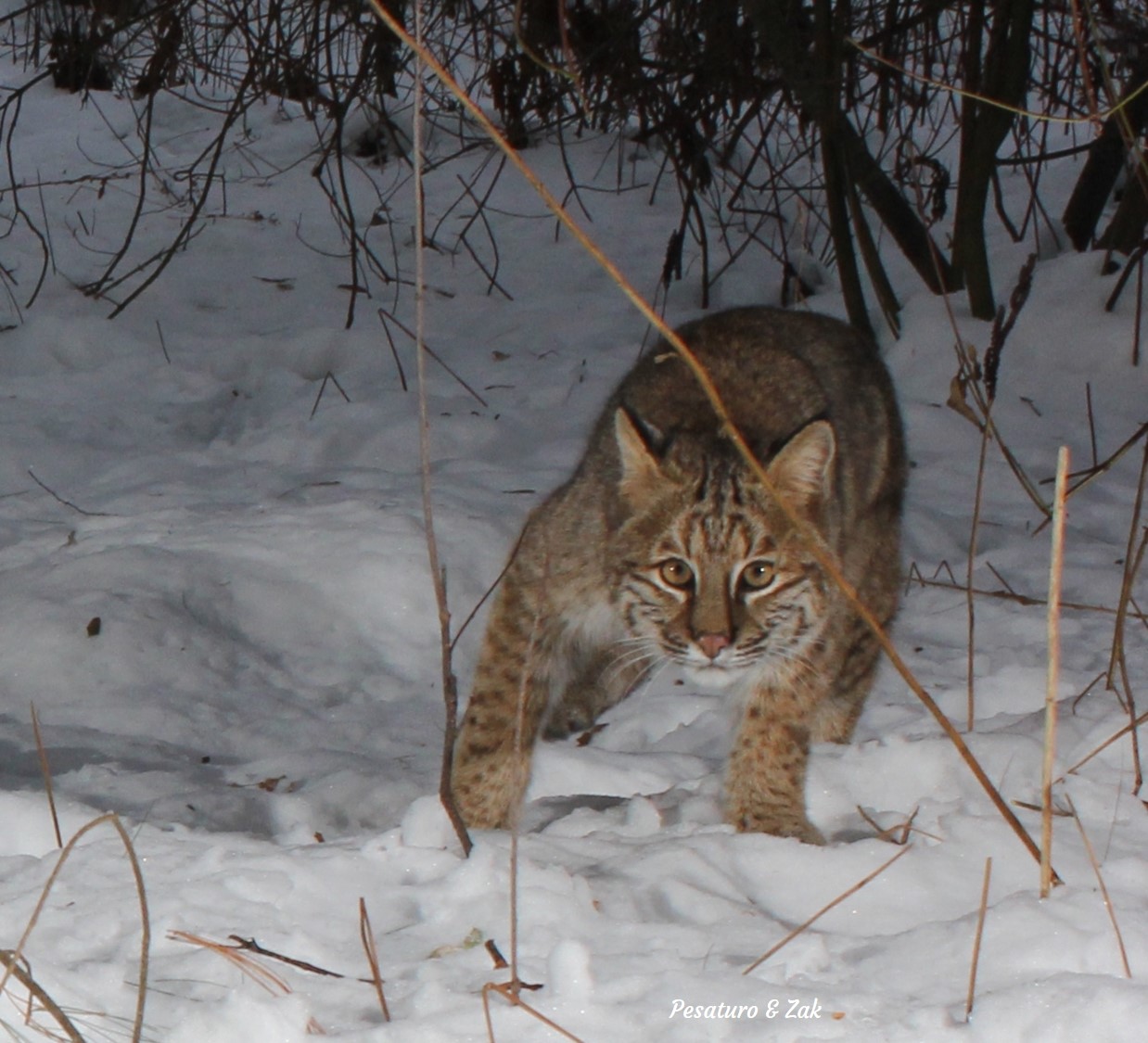
Though the bobcat (Lynx rufus) is common and widespread, it is usually shy and secretive so you are more likely to see its foot prints than the animal itself. Bobcat tracks and trail patterns (also called track patterns) are similar in appearance to those of the domestic cat, but their measurements are bigger…by about a factor of two. Once you have internalized the appearance of the tracks and trails, diagnosis is straightforward in excellent tracking conditions. But so often the tracks we find are indistinct and stretches of the trail are difficult or impossible to see. In that case, knowing something about bobcat behavior can help you determine the species, and in general can enhance your ability to interpret the story in the snow or sand or mud.
Bobcat Tracks and Trail Patterns: The Tracks
As I mentioned above, bobcat tracks look a lot of house cat tracks, except that they are about twice as large. The average width of a bobcat tracks is about 2 inches (with a range of about 1.5 – 2.5 inches). The characteristic features of the tracks are
- Overall track shape is roundish, especially the front tracks. Hind tracks are slightly elongated.
- Claw marks usually do not show, since cats often keep their claws retracted.
- The toe arrangement is asymmetric in a way that is similar to most human hands.
- The large pad, often called the heel or palm pad (but more properly called the metacarpal pad in front tracks and metatarsal pad in hind tracks):
- is large relative to the overall track
- is roughly shaped like a trapezoid
- has a bi-lobed leading edge
- has a tri-lobed back edge
- The negative space between the large pad and the toe pads is C-shaped.
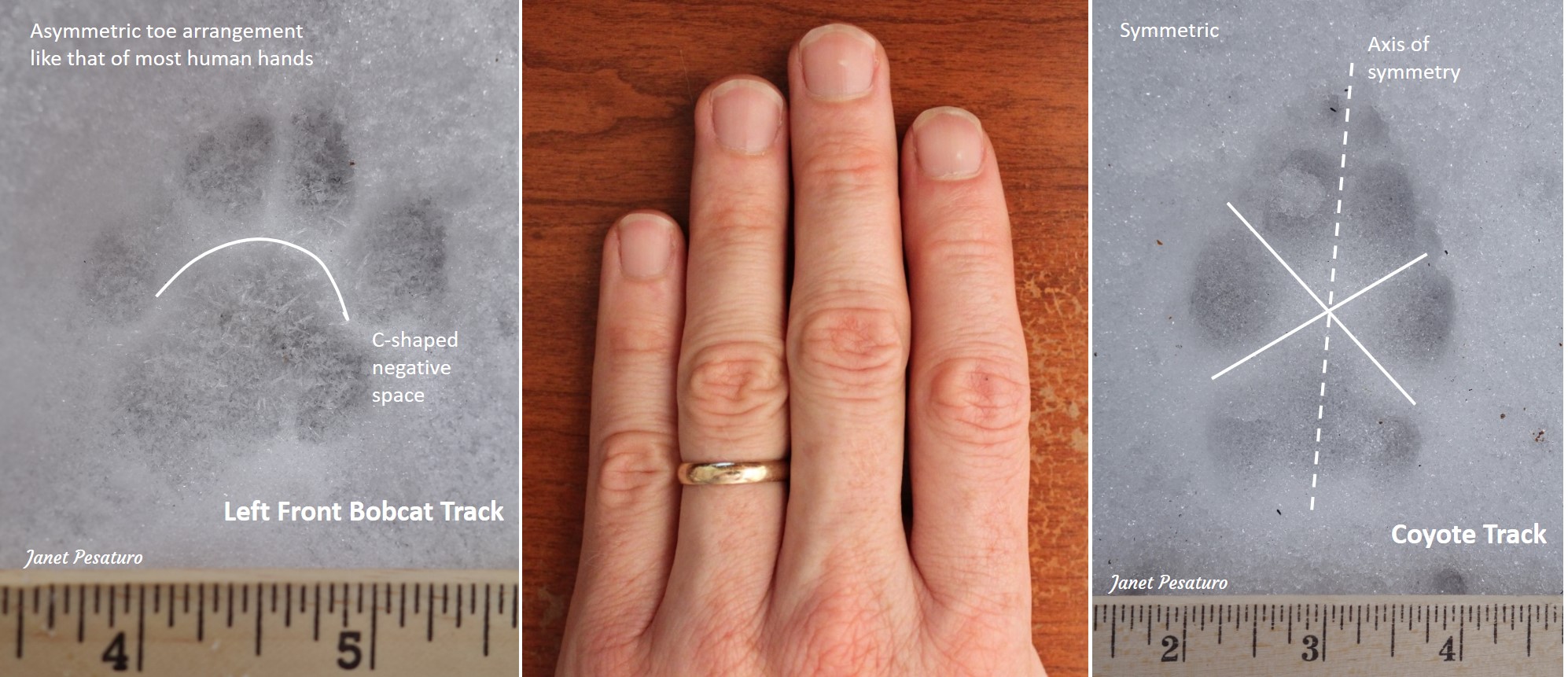
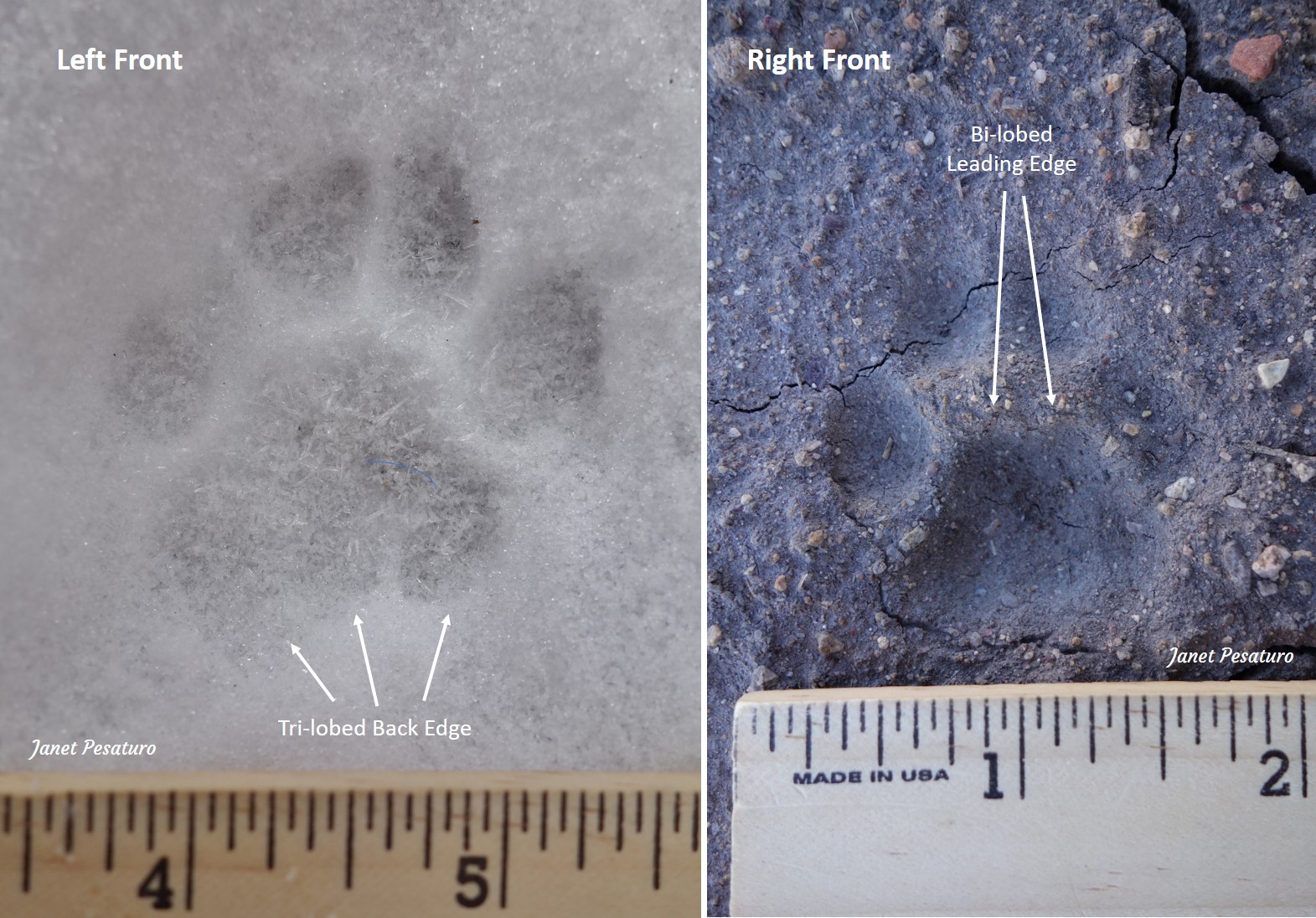
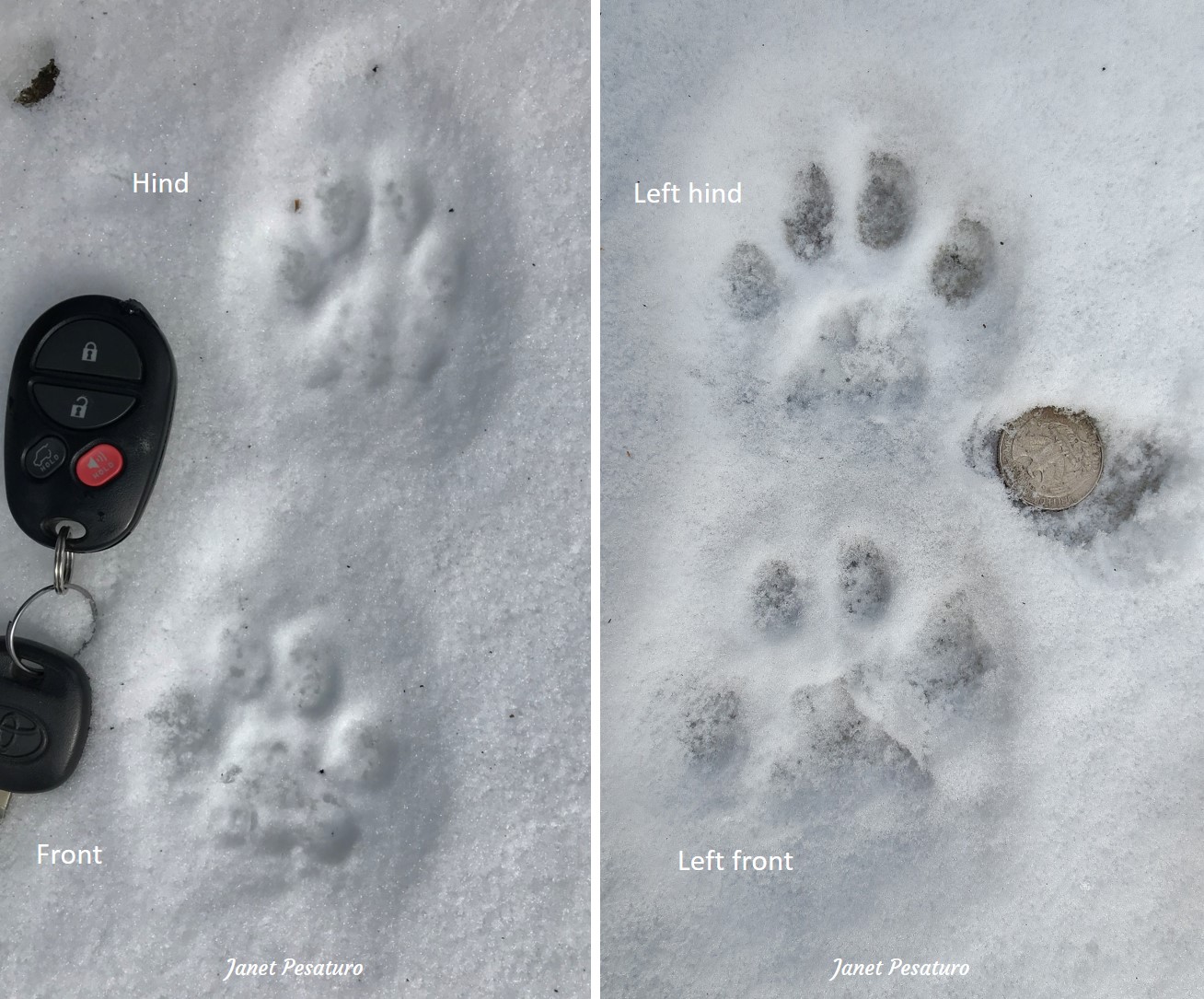
It’s helpful to know those guidelines but remember that they are just guidelines. Don’t expect to find every feature present in every track. Substrate and aging can have a tremendous impact on track appearance. A typical distinction that must be made is feline vs. canine, and the ability to do that comes with experience. It can be simple and straightforward in good substrate but quite challenging in poor conditions. After studying many felid tracks and many canid tracks in different conditions your ability to make the distinction will improve.
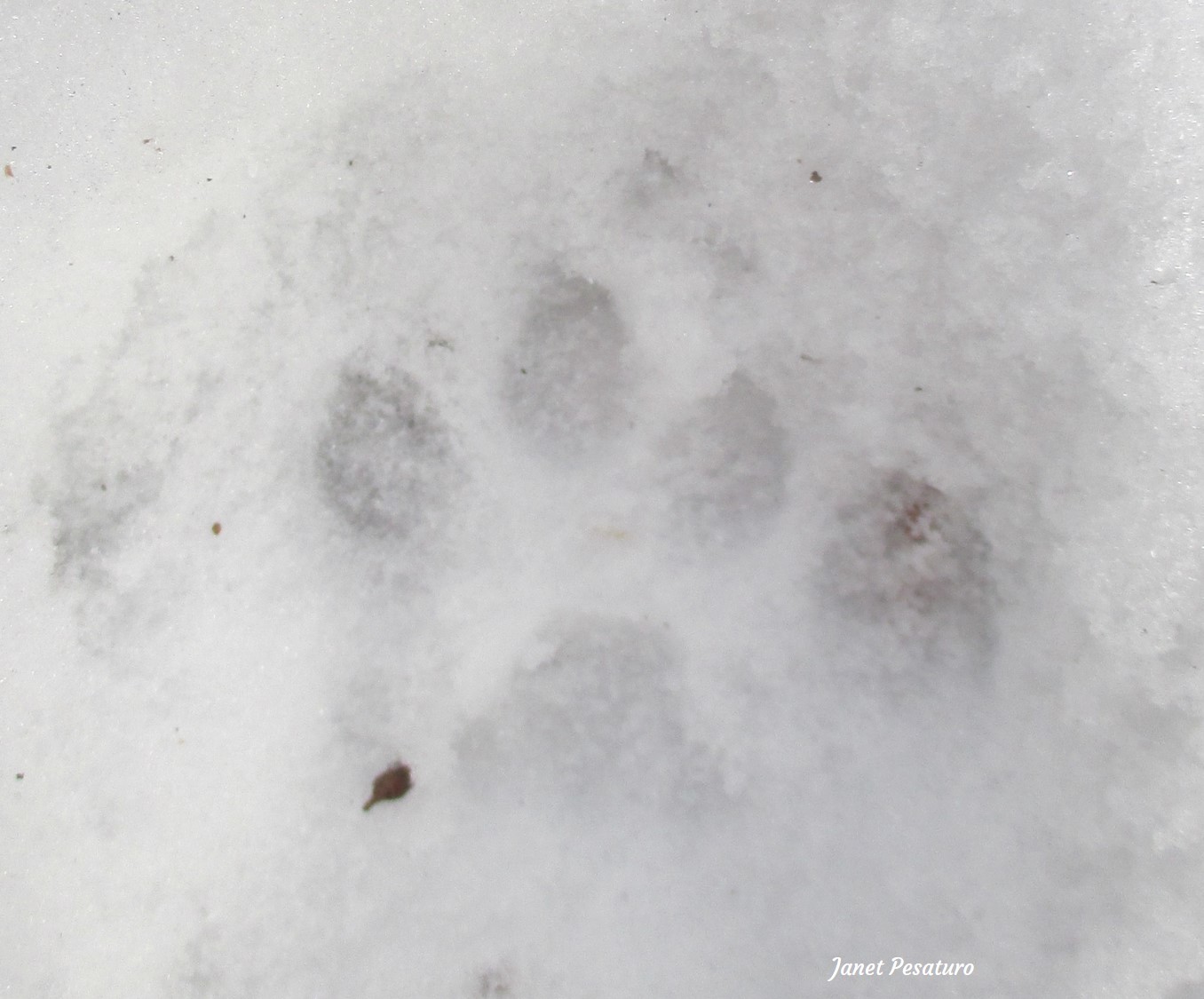
Bobcat Tracks and Trail Patterns: The Patterns
Here I am referring to the pattern of tracks the animal leaves behind as it travels, so it is more properly called a track pattern, but for some reason “trail pattern” has become popular. Regardless of preferred terminology, it’s important to realize that most species can move in a variety of gaits and at a range of speeds, but each species has one or more typical or preferred gaits, and therefore commonly creates certain patterns. And even if you are new to tracking and don’t know anything about track patterns, you have seen house cats move and know they typically walk at a fairly relaxed pace. Bobcats are no different in that regard. The walking gait they use is called an alternating walk.
Direct Register Walking Pattern
In snow that’s at least a few inches deep, bobcats usually create a simple, easily recognized zig zagging pattern of tracks. This is because the hind tracks land directly on top of the front tracks. It’s called a direct register alternating walk. The step length, or distance between one track and the next, is around 6-14 inches and the trail width is 4-9 inches.
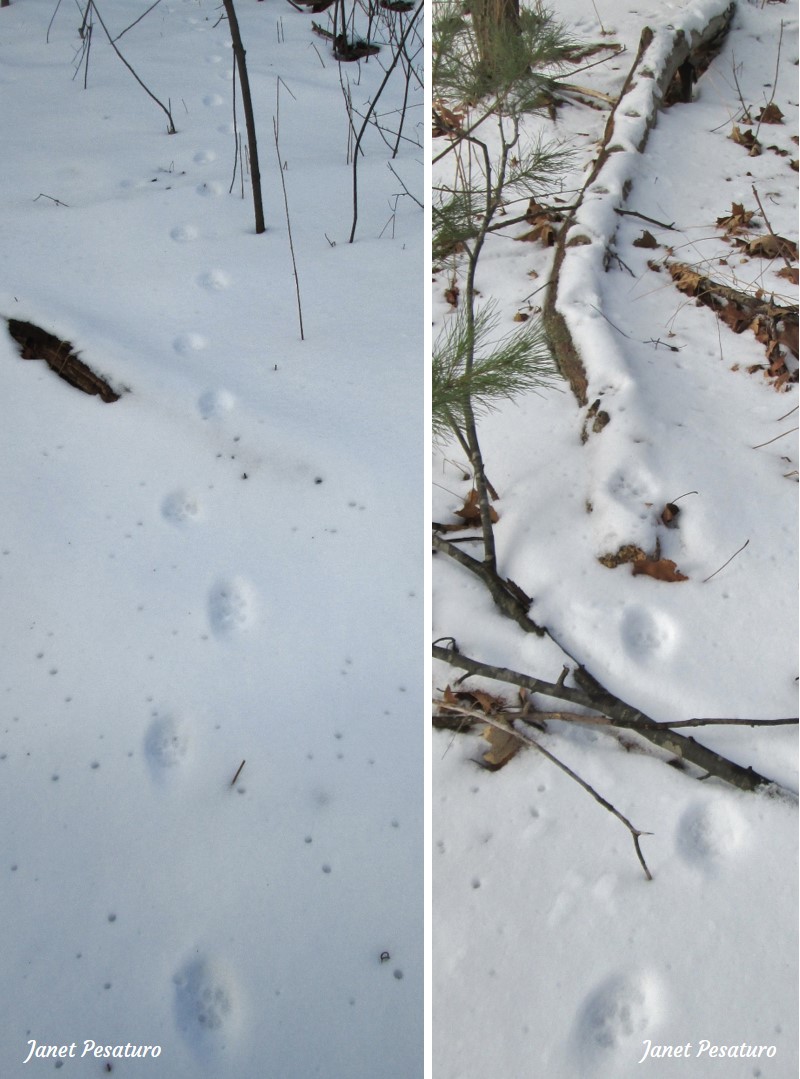
Overstep and Understep Walking Patterns
In firm or shallow substrate, walking bobcats often overstep, meaning that hind tracks land ahead of the front tracks. This overstep pattern can be tricky to distinguish from other track patterns, so it’s helpful to study it carefully and determine which tracks are front and which are hind. Also realize that the appearance of the track pattern differs if the cat oversteps just a little vs. a lot. In the examples below, the overstep is slightly larger in the photo at left.
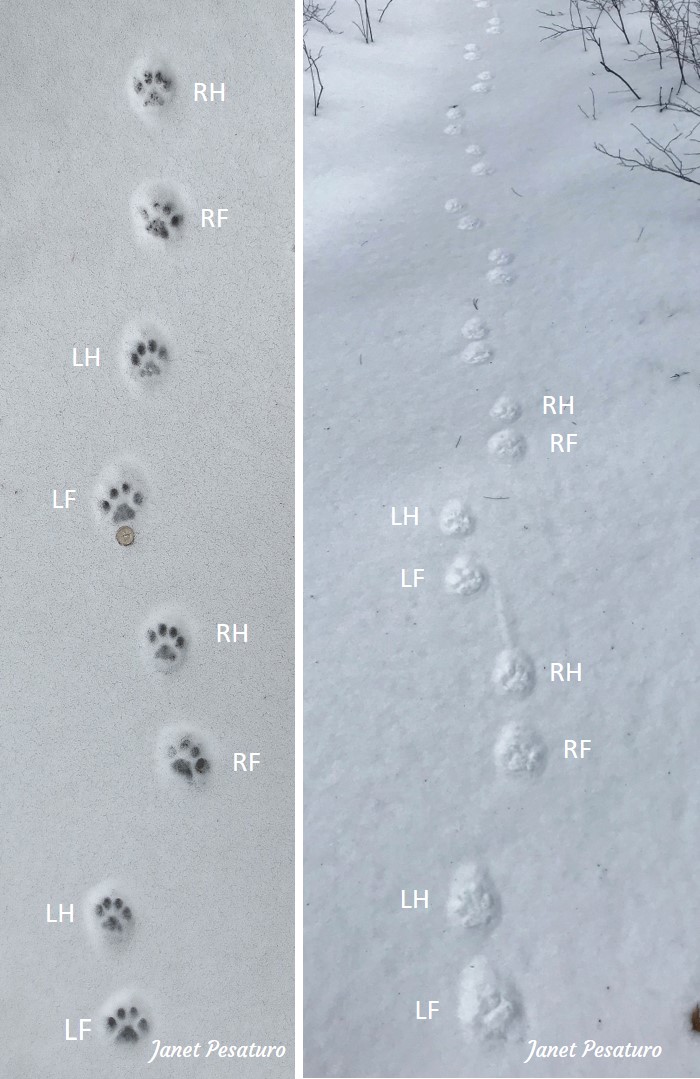
Be careful when analyzing bobcat walk patterns and do not assume that every time it does not direct register, it is overstepping. Occasionally they do understep. In an understep the hind foot lands behind the front foot. Basically, an overstep is associated with a faster pace and an understep is associated with a slower pace.
One situation in which a bobcat may move in an understep walk is while stalking. This makes intuitive sense, because cats usually move slowly when stalking. In the video below, you can see a bobcat direct registering, overstepping, and understepping. And indeed, the understep occurs while the cat is stalking.
Factoring in Behavior
Knowledge of animal behavior is hugely helpful when tracking. It can help you to understand why the tracks and trails appear as they do, to tip the balance toward one species or another, to predict what the animal might do next, etc. Stalking is one example, already discussed. Another example is the bobcat’s tendency to sit down to look around for hunting opportunities. Bobcats do this quite frequently, and in soft substrate you may see sit down prints.
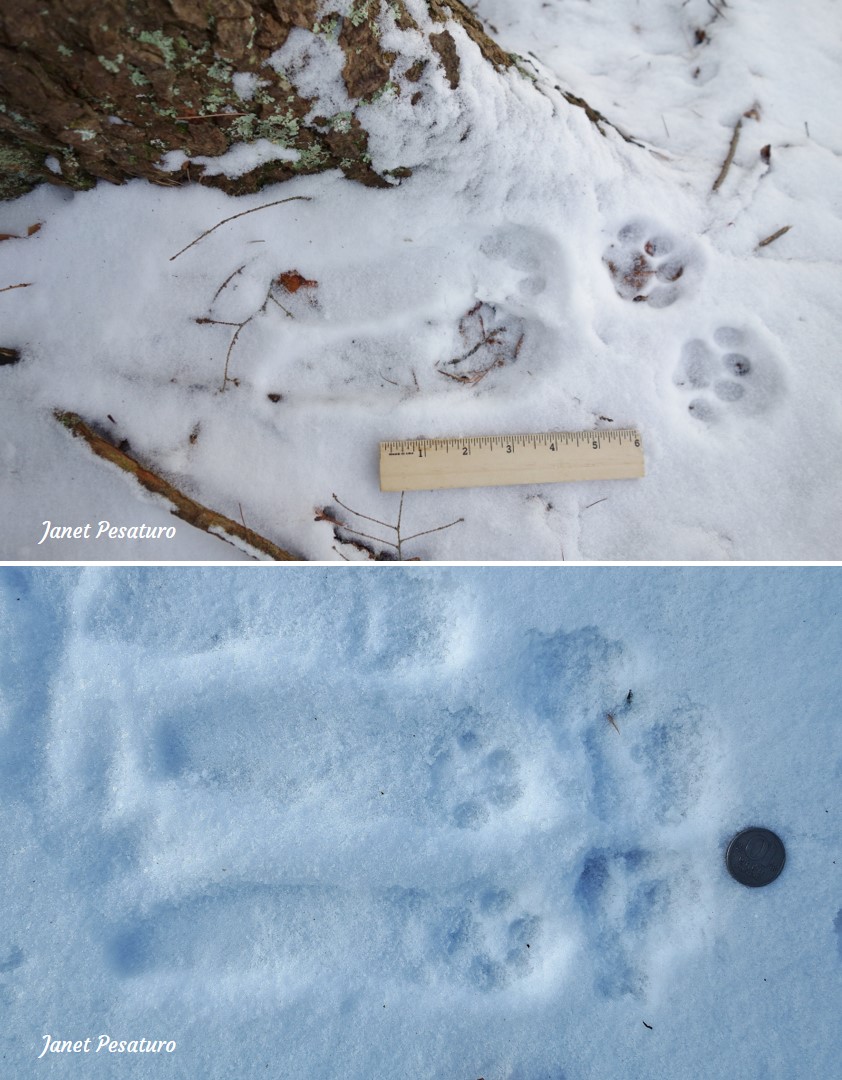
An awareness of seasonal behaviors is also helpful. For example, bobcats mate in winter to early spring, the female gives birth in spring, and kittens remain with their mother into the fall and occasionally the winter. Now check out the next photo of bobcat tracks I found one February while following the trails of two cats walking together. The neat walking trails I was initially following converged and exploded into the jumble of tracks shown below. Most likely this was a male and female in courtship, but it’s also possible that it was a mother and her youngster from the previous spring, or even two juvenile littermates still associating with one another.
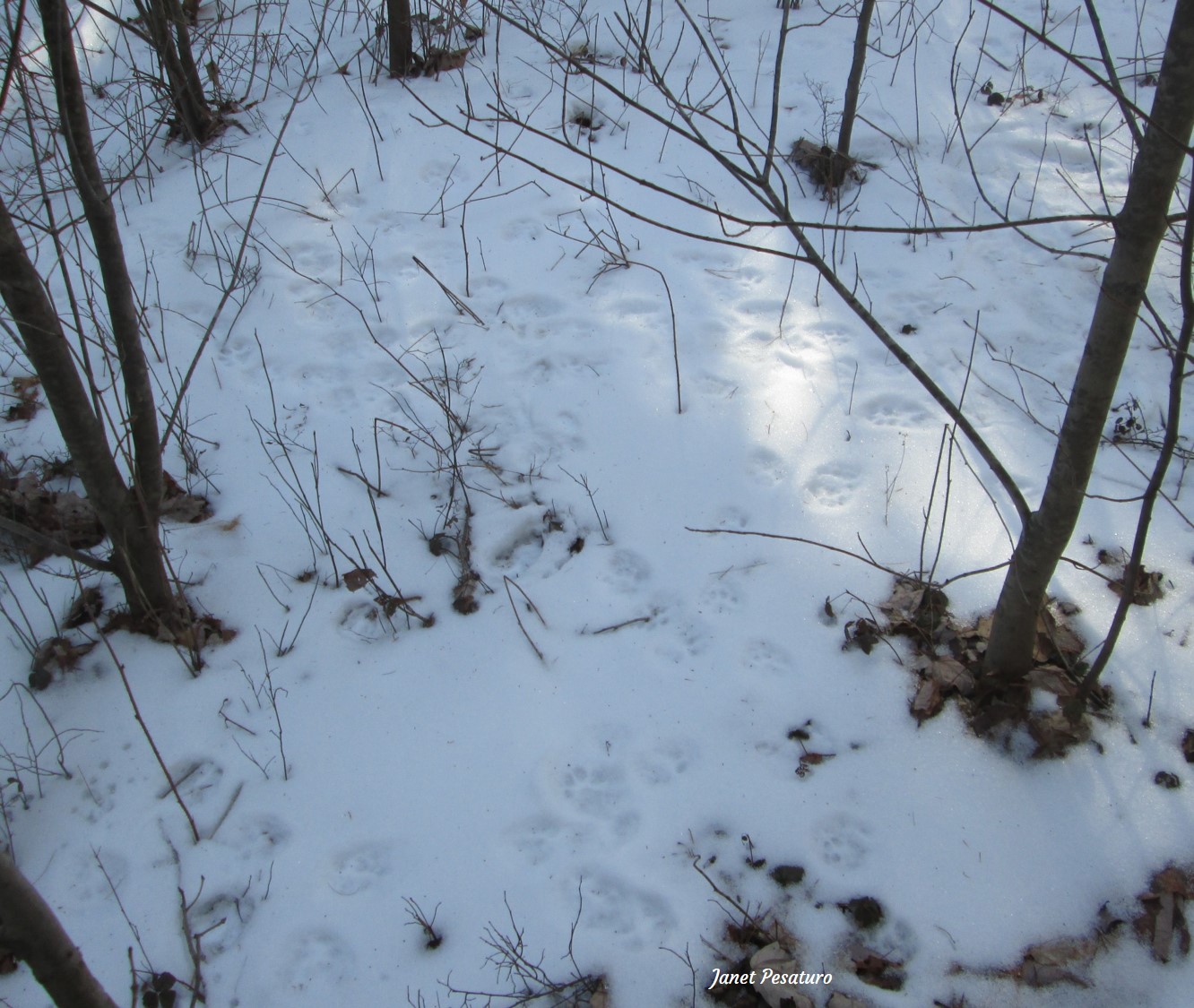
In summer or fall, on the other hand, the trails of two cats converging into a mess of tracks would more likely represent a pair of kittens playing or a mother and kitten playing. I’ve been lucky enough to get bobcats playing on a couple of trail camera videos – see below.
Another bobcat behavior that the tracker will undoubtedly encounter is scent marking. I have already posted here about bobcats scent marking behavior as seen on video, and a future post will focus on finding and recognizing bobcat scent posts.
What are your questions, observations, or tips on recognizing bobcat tracks and trail patterns? Share your thoughts in a comment below.
For a large gallery of bobcat tracks in different substrate conditions, check out this site.

Janet,
I really enjoy your e-mails! Great photos and videos.
Thanks! So glad to know they are useful.
We have a trail of tracks that are very narrow almost straight like what you would see with a fox but sm and round like the bobcat tracks you show here. It goes a long ways ( over 1/2 mile) like this on our logging trail near our home. We see it every winter. Could that be a bob cat? We are in South Paris Maine
Don’t know. I’d have to see photos with something of standard size (like a ruler or coin) for scale. If track morphology is not clear, it really helps to see exact size of the track, as well as the trail pattern and exact step length and trail width, to determine species. If you have such photos, you could email them to me at the address in the Home tab and then under Contact.
Hi, thanks for this great blog post. I’m going to have a good look all round your blog in a bit, great stuff. Just now I have a question.
I just found a set of what I believe to be bobcat tracks in a remote-ish area of the Illinois property I live on (Illinois valley, a wooded, hilly area) and they present a pattern I’ve never heard of and can’t seem to find in a websearch: a very neat double row of tracks. Like a neatly spaced line of sets of two tracks each, perfectly lined up with each other, maybe an inch, 1 1/2 inch apart.
Is this a known thing with bobcat tracks, some particular gait? What would you suppose this was?
(I can’t confirm absolutely that they were bobcat tracks, only that they were very catlike–no claws, catlike pad–seemed too large for a domestic cat, the area too remote for any of the local domestic cats, and we’ve had researchers trap & tag a couple bobcats on the property, so that seems the logical conclusion. I hope to learn the specific shapes of tracks in more detail–again thanks for this very good blog.)
Hi, no that is definitely not a known bobcat pattern. I do have a hunch of what it was but would love to see photos, preferably with something for scale in them. If you have any photos and would like to send them, email to me at janet(at)OurOneAcreFarm(dot)com
Thanks so much for answering! I’m afraid I can’t get photos now b/c the tracks were in fresh snow that melted before I got back out to that location. I’ll keep an eye out in that location in the next couple weeks though, as I go there daily to do pruning, and I’ll get photos if I see it again.
Sounds good. My suspicion is that they were raccoon tracks, because that pattern of a neat double row of tracks is a common raccoon pattern. Members of the weasel family can make a similar pattern, but raccoons are very common and the chances of finding raccoon tracks in that pattern are very high.
I have found tracks on my hike by my cottage that I would love to have identified…its either wildcat or coyote..thankyou
I have a strange request- We know we have at least one bobcat roaming around. I found very unusual print that I am utterly clueless. I am wondering if it is markes from a babcat relieving itself. Do you have any such picture? I can share mine and maybe you would know. I’ve never seen anything like it.
I’d be happy to take a look at your photo. This platform does not allow photos in comments so you’ll have to email it to me. You can send it to janet (at) OurOneAcreFarm (dot) com. (I don’t type it as a normal email address because it would get picked up by spammers who would flood my inbox)
Thankyou…i just sent the photos☺️
I never got the photos. Wondering if you had a typo in my email address? Feel free to send again.
Hello! I have a friend who found some tracks in Ontario, Canada that they are unsure of. They say either a lynx (Lynx Genus, I am not really sure how similar lynx and bobcat tracks are but I assume very similar), or a dog with really hairy feet. They say that lynxes have been spotted in the area, but the tracks were also found along a pathway where dogs travel often. The front pads are wide, rounded, and asymetrical like a bobcat’s. However, what appears to be the hind feet are very elongated, but longer than the hind feet in your photos. Also, the pattern is throwing me off a litte. Note, I am not a very experienced tracker. I have several photos of the tracks as well as a comparison of a dog’s tracks.
Hi! Please feel free to send the photos to me at janet(at)OurOneAcreFarm(dot)com (use appropriate symbols in place of the parenthetic words at and dot; I have written it this way to deter spammers)
I just casted 5 toed bobcat track
Perhaps a hind track imprecisely superimposed on a front track in a walking pattern.
Love these videos! I’m wondering what trail cam you recommend. I live in eastern Ontario – lots of bush and wetland. Hoping to find bobcat track this winter:)
Hi! If you haven’t used trail cams before I would start with a cheap one from Amazon. You will soon figure out what features and settings are most important to you. Honestly ALL trail cam brands and models models have quirks and flaws. I personally love my Browning HP5’s but that is just what works for me. If you ask 10 different experienced camera trappers you will probably get 10 different answers. Good luck!
In the “low cost” category, consider GuardPro White flash. See review at: https://winterberrywildlife.ouroneacrefarm.com/2023/11/18/gardepro-t5wf-white-flash-trail-camera/
Hi, I’m in midwestern North Carolina and I work taking care of the landscape for a large rural property. I was blowing leaves off of a leveled red dirt pad in prep for a bldg and saw some tracks on it. I stopped and took pics of them and was thinking initially that they might be bobcat tracks because I could see no claw marks, but since looking up tracks and patterns, I think they might be coyote tracks that just didn’t leave the claws for some reason? I trust your knowledge and wonder if I could send you a couple of pics to see what you think? Thanks!
Hi Mike, yes please do send the photos. I will reply by email so that you can do so
Hello. I’m in north central Oklahoma on semi rural 5 acre property. May I email you some photos at the address in other comments for ID. In our recent snow I believe I found bobcat & coyote along with the many other small mammals we see routinely.
Thx
Yes, do feel free to email the photos to me.
Can I email some pics of tracks in Bracebridge Ontario.
Cant tell if they are bobcat, maybe juvenile, or fox.
The tracks are larger than a house cat, and the gait has the prints at least 15 maybe as much 25cm apart.
The tracks appear to have elongation in rear prints slightly.
Thanks for your help
Yes. I will email you.